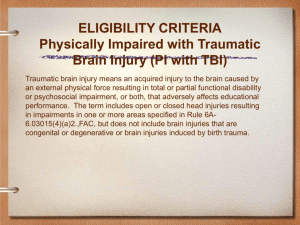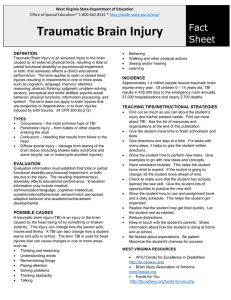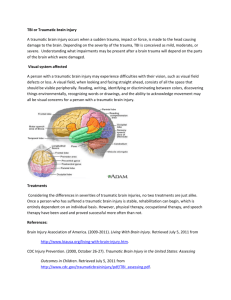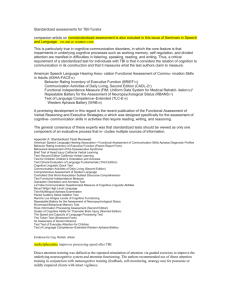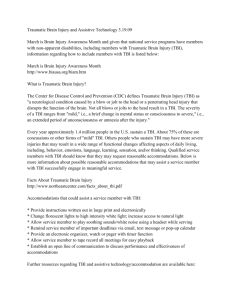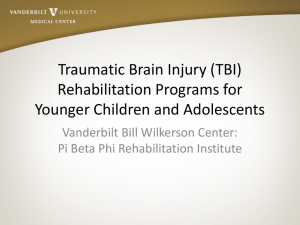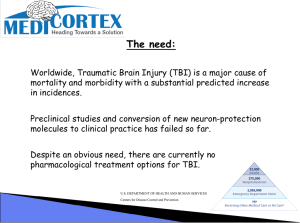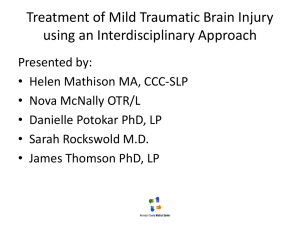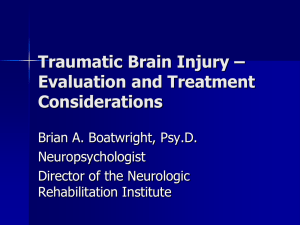OSUMCPowerPointTemplate Master - Brain Injury Association of Ohio
advertisement
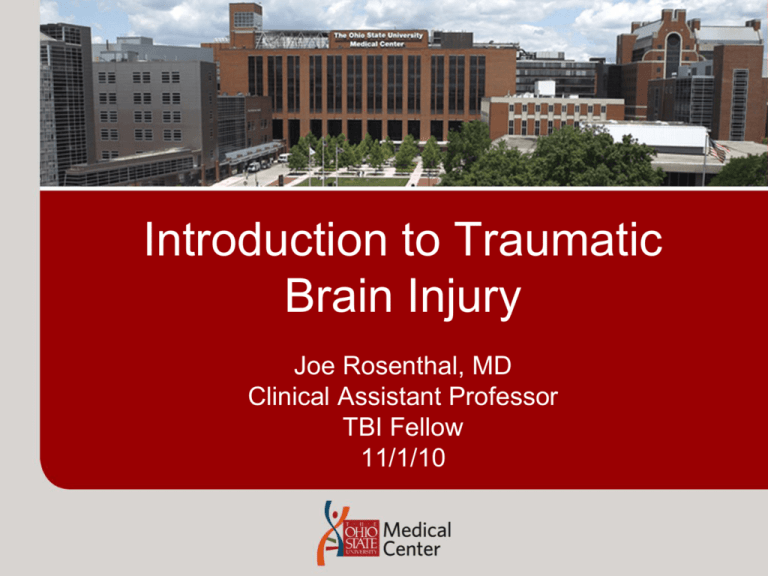
Introduction to Traumatic Brain Injury Joe Rosenthal, MD Clinical Assistant Professor TBI Fellow 11/1/10 Objectives • • • • • • Definition Epidemiology Severity of injury Mechanisms/Types of Brain Injury Symptoms/Treatment Return to work and driving Definition • Nondegenerative, noncongenital insult to the brain from an external mechanical force, possibly leading to permanent or temporary impairments of cognitive, physical, and psychosocial functions with an associated diminished or altered state of consciousness www.cdc.gov/features/dsTBI_BrainInjury/ National Center for Injury Prevention and Control at the Center for Disease Control Survival in the USA • Mild (80% of all TBI’s) – 100% (nearly) survive • Moderate (10% of all TBI’s) – 93% survive • Severe (10% of all TBI’s) – 42% survive Risk Factors • • • • • • • • Young (15-24 year olds – Highest Risk) Low income Unmarried Minority Inner city Male (2x more likely) Substance abuse Previous TBI Common Causes in the United States • #1 MVA – 50% – 2.4:1 Male • #2 Falls – 20-30% (most common > 75 yo) • #3 Firearms – 12% (age 25-34) – 6:1 Male What is the Most Common INDIRECT Cause of TBI? Most Common INDIRECT Cause ALCOHOL TBI Spectrum Mild/Concussion Moderate Severe Death Determining Severity • • • • Loss of Consciousness Duration Post Traumatic Amnesia & Confusion Wounds, Bruising, Swelling Tools: – Glascow Coma Scale (GCS) – Radiographic Imaging Mild TBI • Traumatically induced physiologic disruption of brain function, as manifested by one of the following: – LOC up to 30 minutes – Anterograde or retrograde amnesia not greater than 24 hours – Altered mental status – Focal neurologic deficits • Headaches, nausea, wooziness, etc. Other Mild TBI Criteria • • • • GCS 13-15 No Head CT abnormalities Hospital stay < 48 hrs No operative lesions Complicated Mild TBI • Mild TBI with small amount of bleed, bruising, swelling, or skull fracture seen on imaging • Higher risk of more chronic symptoms Moderate TBI • • • • • • GCS 9-12 PTA>24hrs Coma duration 20 minutes to 6 hours Abnormalities on CT Operative intracranial lesion Hospital stay at least 48 hrs Severe TBI • GCS 3-8 • Coma duration 6+ hours Why is the Brain so Vulnerable? Brain Injury Types • • • • • Contusion DAI Penetrating Injuries Intracranial Hemorrhage Secondary Injuries (including Hypoxia) Contusion • • • • • • Low velocity impact Often symmetric (coup-countercoup) Not responsible for coma Focal deficits Recovery dependent on size and location Occasionally require resection Injury Not Always Just at Impact Site Diffuse Axonal Impact • High velocity impact • Almost always has some time of unconsciousness • Diffuse pattern of deficits • Recovery gradual Diffuse Axonal Injury • Widespread stretching of axons – Rotation on axis – Acceleration-deceleration • Mild force - external • Severe force - internal • Often imaging is normal http://braininjury.blogs.com/photos/uncategorized/closedheadinjury.jpg Penetrating Injuries • Missile (Gun shot wound) • Non-missile (ice pick) • Only primary mechanism on the rise Penetrating Injuries • GSW – Damage along track of bullet and embedded bone fragments – Usually lead to focal deficits • Energy = ½ mass x velocity squared – High velocity missiles cause most damage Intracranial Hemorrhage • Epidural Hematoma – Impact loading with laceration of dural arteries – Often with fracture of temporal bone and tear of middle meningeal artery. – RAPID neurologic deterioration Intracranial Hemorrhage • Subdural Hematoma – Injury to cortical bridging veins most common – Slow collection of blood – “Lucid interval” • Actress Natasha Richardson – High mortality rate – Often need evacuation Intracranial Hemorrhage • Intraparenchymal hemorrhage – Cerebral parenchyma – Injury to deeper, larger cerebral vessels – Different mechanism and often more diffuse deficits compared to CVA bleed Intraventricular Hemorrhage – Occur with very severe TBI – Unfavorable prognosis due to severity of injury Anoxic/Hypoxic Brain Injury • Caused by lack of oxygen to brain • Most common cause: Cardiac Arrest • Other causes: near drowning, infection, respiratory arrest, choking, Carbon Monoxide poisoning, etc. Wijdicks EFM, Campeau NG, Miller GM (2001) Secondary Injuries • Systemic – – – – – – – Hypoxia/Anoxia Hypotension Anemia Hyperthermia Hyper/hypocarbia Fluid imbalance Sepsis • CNS – – – – – – – Brain swelling (Inc ICP) Hemorrhage/Hematoma Brain herniation Seizures Hydrocephalus Ischemia Infection Journey to Recovery Immediate Treatment • Observation – alertness, confusion, Headache, nausea, etc. • Blood Pressure & other vitals monitoring • Imaging • Surgery • Intracranial Pressure Monitoring Traumatic Brain Injury Sequela • • • • • • • • • • • Agitation Mood Disorder Sleep Disturbance Motor Dysfunction Cognitive Deficits Headaches Decreased Arousal Bowel & Bladder Dysfunction Pain Syndromes Seizures Denial of Disability Amnesia http://braininjuryrx.com/2009/06/misconceptions-made-by-nursing-students-about-amnesia-in-tbi/ Posttraumatic Amnesia Definitions • period of impaired consciousness after brain injury • “ending” at the time the patient can give a clear, consecutive account of what is happening around them • absence of continuous memory or inability to retain new information • broader syndrome of disorientation, confusion, diminished memory, reduced capabilities to attend to and respond to environmental issues Post- Traumatic Headaches • Very common, especially after Mild-Mod TBI • Different Types: – Migraine – Tension – Related to Neck injury/pain • Treatment – Time – Medications Sleep Disorders • Trouble Falling Asleep – Common after TBI – Often treated with good sleep hygiene and/or meds • Trouble Staying Awake – Decreased arousal during the day – Tx: good sleep hygiene, medications • Nightmares – Associated with PTSD Cognitive Changes http://www.braybray.co.uk/cms/photo/misc/head_injuries.gif Other Cognitive Deficits • Short Term and Working Memory Problems • Decreased Attention • Cognitive Fatigue • Problem Solving difficulties Emotional/Personality Changes • • • • • Depression Anxiety Irritability Anger/Aggression Obsessive/Compulsive • Often pre-injury psychiatric conditions are exacerbated after injury Incidence of Anxiety and Depression after Traumatic Brain injury • Depression • Anxiety • Anxiety and depression 61% 17% 60% Frequent Complaints with TBI related Depression • • • • Frustration Restlessness Boredom Sadness 81% 73% 66% 66% Treatment • For the most part, same as non-injured pts – Counseling – Anti-depressants – Other medications – Monitor for other conditions that can cause Depression (i.e. low thyroid) Movement Disorders • • • • Weakness Spasticity Abnormal movements Difficulty coordinating movements Visual Deficits • • • • Blurry Vision Double Vision Trouble opening and closing eyelids Blindness Dizziness & Vertigo • Inner ear damage -- ringing in ears • Lightheadedness from blood pressure problems • Injury directly to brain resulting in these symptoms • Tx Other Senses • Taste change • Loss of smell • Numbness/tingling Post Concussive Syndrome Persistent, chronic symptoms after the expected time of recovery -Headache, dizziness, fatigue, irritability, sleep disturbance, mood changes, etc. Controversial -Definition -Timing (1 month vs 3 months) -# of symptoms Rehabilitation Multi-Disciplinary Approach • Physicians – – – – Medication Monitoring labs Managing therapies Clearance for return to work/drive • Nursing (in-patient) – Bowel and bladder – Wound Care – Family education • Therapists – PT/OT/ST/Rec Therapy – Community re-entry, assist with return to work/driving • Neuropsychologist – Testing – Counseling • FAMILY/FRIENDS Return To Work • Dependent on multiple factors – Severity of injury – Cognitive functioning – Type of job – Symptoms – Physical limitations Return to Work • Tools to assess readiness – Physician visits – Therapy reports – Neuropsychological testing Epidemiology of Traumatic Brain Injury in the United States Return to Work • mild • moderate • severe 90-100% poor data 10-25% Return to Work Possible Accommodations • • • • • • New position (less demanding, safer) Frequent rest breaks Return Part Time Work Conditioning/Hardening with therapy Vocational Training (BVR) Memory Aids Return to Driving • Again, dependent on multiple factors – – – – – Severity of injury Cognitive functioning Symptoms Physical limitations Seizures • Tools to assess readiness – Therapy results – Vision evaluation – Driver’s Evaluation Questions References • • • • • • • • Brain injury medicine. Principles and Practice. 2007. Physical medicine and rehabilitation: Principles and practice. Fourth edition.2005. Physical medicine and rehabilitation board review. 2004. Pharmacologic enhancement of cognitive and behavioral deficits after traumatic brain injury. Olli Tenovuo. Current Opinion in Neurology 2006, 19:528-533. High-Yield Neuroanatomy. Second Edition. 2000 Traumatic brain injury diagnosis and outcome. W. Jerry Mysiw, M.D. eMedicine – Traumatic brain injury: Definition, epidemiology, pathophysiology. http://www.emedicine.com/pmr/topic212.htm Sleep disturbances following Traumatic Brain Injury. Rao V & Rollings P. Current Treatment Options in Neurology. 2002, 4:77-87.
